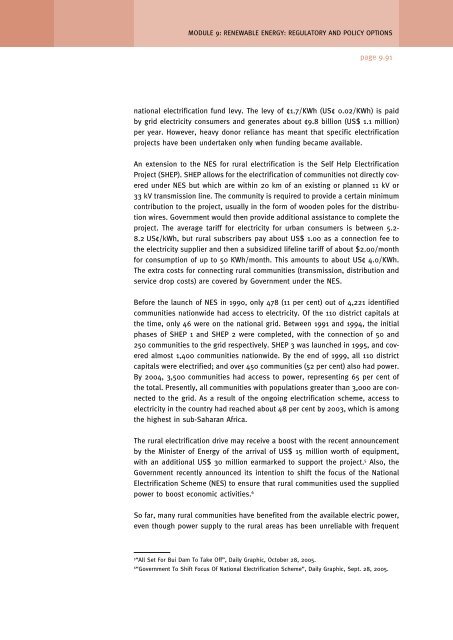Regulatory and policy options to encourage development of ...
Regulatory and policy options to encourage development of ...
Regulatory and policy options to encourage development of ...
- No tags were found...
You also want an ePaper? Increase the reach of your titles
YUMPU automatically turns print PDFs into web optimized ePapers that Google loves.
MODULE 9: RENEWABLE ENERGY: REGULATORY AND POLICY OPTIONSpage 9.91national electrification fund levy. The levy <strong>of</strong> ¢1.7/KWh (US¢ 0.02/KWh) is paidby grid electricity consumers <strong>and</strong> generates about ¢9.8 billion (US$ 1.1 million)per year. However, heavy donor reliance has meant that specific electrificationprojects have been undertaken only when funding became available.An extension <strong>to</strong> the NES for rural electrification is the Self Help ElectrificationProject (SHEP). SHEP allows for the electrification <strong>of</strong> communities not directly coveredunder NES but which are within 20 km <strong>of</strong> an existing or planned 11 kV or33 kV transmission line. The community is required <strong>to</strong> provide a certain minimumcontribution <strong>to</strong> the project, usually in the form <strong>of</strong> wooden poles for the distributionwires. Government would then provide additional assistance <strong>to</strong> complete theproject. The average tariff for electricity for urban consumers is between 5.2-8.2 US¢/kWh, but rural subscribers pay about US$ 1.00 as a connection fee <strong>to</strong>the electricity supplier <strong>and</strong> then a subsidized lifeline tariff <strong>of</strong> about $2.00/monthfor consumption <strong>of</strong> up <strong>to</strong> 50 KWh/month. This amounts <strong>to</strong> about US¢ 4.0/KWh.The extra costs for connecting rural communities (transmission, distribution <strong>and</strong>service drop costs) are covered by Government under the NES.Before the launch <strong>of</strong> NES in 1990, only 478 (11 per cent) out <strong>of</strong> 4,221 identifiedcommunities nationwide had access <strong>to</strong> electricity. Of the 110 district capitals atthe time, only 46 were on the national grid. Between 1991 <strong>and</strong> 1994, the initialphases <strong>of</strong> SHEP 1 <strong>and</strong> SHEP 2 were completed, with the connection <strong>of</strong> 50 <strong>and</strong>250 communities <strong>to</strong> the grid respectively. SHEP 3 was launched in 1995, <strong>and</strong> coveredalmost 1,400 communities nationwide. By the end <strong>of</strong> 1999, all 110 districtcapitals were electrified; <strong>and</strong> over 450 communities (52 per cent) also had power.By 2004, 3,500 communities had access <strong>to</strong> power, representing 65 per cent <strong>of</strong>the <strong>to</strong>tal. Presently, all communities with populations greater than 3,000 are connected<strong>to</strong> the grid. As a result <strong>of</strong> the ongoing electrification scheme, access <strong>to</strong>electricity in the country had reached about 48 per cent by 2003, which is amongthe highest in sub-Saharan Africa.The rural electrification drive may receive a boost with the recent announcementby the Minister <strong>of</strong> Energy <strong>of</strong> the arrival <strong>of</strong> US$ 15 million worth <strong>of</strong> equipment,with an additional US$ 30 million earmarked <strong>to</strong> support the project. 5 Also, theGovernment recently announced its intention <strong>to</strong> shift the focus <strong>of</strong> the NationalElectrification Scheme (NES) <strong>to</strong> ensure that rural communities used the suppliedpower <strong>to</strong> boost economic activities. 6So far, many rural communities have benefited from the available electric power,even though power supply <strong>to</strong> the rural areas has been unreliable with frequent5“All Set For Bui Dam To Take Off”, Daily Graphic, Oc<strong>to</strong>ber 28, 2005.6“Government To Shift Focus Of National Electrification Scheme”, Daily Graphic, Sept. 28, 2005.










